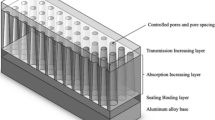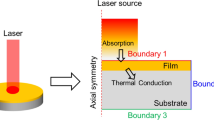Abstract
A continuous wave (cw) laser beam with extremely high power density is needed in the experimental study of the optical film’s thermal damage. In order to achieve such high power density, the incident beam generally needs to converge. In this situation, the cone-angle of the converged beam is inevitable, which may affect the damage process of the optical film. A thin-film Fabry–Perot filter is taken as an example. The influence of the beam cone angle on the thermal damage of the optical film is theoretically studied. Under the irradiation of high power cw laser, the film absorbs the laser energy and the heat accumulates continuously in the film. The cone-angle changes the laser intensity distribution, i.e. the heat source, in the multilayer film. The temperature distribution and the temperature rising process are also related to the cone-angle. Only when the cone’s half angle is smaller than 2°, the influence of the cone-angle may be ignored.






Similar content being viewed by others
References
E. Gerhard, L. Hans, L.M. Douglas, Optical Coatings: Material Aspects in Theory and Practice (Springer, Heidelberg, 2014)
R.M. Wood, Laser induced damage thresholds and laser safety levels. Do the units of measurement matter? Opt. Laser Technol. 29, 517–522 (1998)
B. Ma, Y. Zhang, H. Ma et al., Influence of incidence angle and polarization state on the damage site characteristics of fused silica. Appl. Opt. 53(4), A96–A102 (2014)
X. Cheng, Z. Shen, H. Jiao et al., Laser damage study of nodules in electron-beam-evaporated HfO2/SiO2 high reflectors. Appl. Opt. 50(9), C357–C363 (2011)
Q. Wang, P.L. Kim, Dual-layer ultrathin film optics: I. Theory and analysis. J. Opt. 17(3), 035613 (2015)
A.A. Manenkov, Fundamental mechanisms of laser-induced damage in optical materials: today’sstate of understanding and problems. Opt. Eng. 53(1), 10901 (2014)
N.B. Podymova, A.A. Karabutov, E.B. Cherepetskaya, Laser optoacoustic method for quantitative nondestructive evaluation of the subsurface damage depth in ground silicon wafers. Laser Phys. 24(8), 086003 (2014)
H. Jiao, X. Cheng, J. Lu et al., Effects of substrate temperatures on the structure and properties of hafnium dioxide films. Appl. Opt. 50(9), C309–C315 (2011)
W. Han, L.D. Zhou, F.Q. Li, J. Wang, F. Wang, B. Feng, Laser-induced damage of a large-aperture potassium dihydrogen phosphate crystal due to transverse stimulated Raman scattering. Laser Phys. 23(11), 116001 (2013)
C. Li, Y. Ma, D. Wang, Z. Wang, X. Zhang, H. Liu, Long-pulse laser-induced damage in an optical anti-reflective film: II. Experimental research. Laser Phys. 24(12), 126003 (2014)
H. Jiao, X. Cheng, G. Bao et al., Study of HfO2/SiO2 dichroic laser mirrors with refractive index inhomogeneity. Appl. Opt. 53(4), A56–A61 (2014)
H. Liang, J. Lai, Z. Zhou, Ultra-narrowband infrared thermal emitter based on Fabry–Perot-like vacuum resonance cavity. J. Opt. A: Pure Appl. Opt. 11(10), 105001 (2009)
J. Zhang, Y. Xie, X. Cheng et al., Thin-film thickness-modulated designs for optical minus filter. Appl. Opt. 52(23), 5788–5793 (2013)
X. Cheng, B. Fan, J.A. Dobrowolski et al., Gradient-index optical filter synthesis with controllable Opt. Express and predictable refractive index profiles. 16(4), 2315–2321 (2008)
Y. Jiang, X. Xiang, X.D. Yuan, C.M. Liu, H.J. Wang, C.S. Luo, S.B. He, H.B. Lv, W.G. Zheng, X.T. Zu, Characterization of 355 nm laser-induced damage of mitigated damage sites in fused silica. Laser Phys. 23(2), 026001 (2013)
V. Staffan, L. Jürgen, R. Heike, P. Alexa, L.A. Bernhard, Comparison of tissue damage caused by various laser systems with tissue tolerable plasma by light and laser scan microscopy. Laser Phys. Lett. 10(10), 105602 (2013)
J. Hu, J. Wang, X. Zhou, S. Chen, P. Ma, Q. Xu, Fluence uncertainties of laser damage threshold measurements. Laser Phys. 24(1), 016003 (2014)
Z.T. Liu, Y. Zhang, M. Pang, Insight into the degradation mechanism resisting the laser-induced damage of optical films in vacuum by evolution of laser-induced defects. Laser Phys. 23(2), 026002 (2013)
Z.T. Liu, Y. Zhang, M. Pang, Metallographic study of laser thermal shock on a piston. Laser Phys. 23(2), 026002 (2013)
J. Souto, J.L. Pura, J. Jiménez, About the physical meaning of the critical temperature for catastrophic optical damage in high power quantum well laser diodes. Laser Phys. Lett. 13(2), 025005 (2016)
Funding
Funding was provided by National High Technology Research and Development Program of China (Grant No. 2015AAXXX3037).
Author information
Authors and Affiliations
Corresponding author
Rights and permissions
About this article
Cite this article
Kai, H. The influence of beam-cone-angle on the high energy laser induced damage of optical thin film. J Opt 47, 278–282 (2018). https://doi.org/10.1007/s12596-018-0467-9
Received:
Accepted:
Published:
Issue Date:
DOI: https://doi.org/10.1007/s12596-018-0467-9




